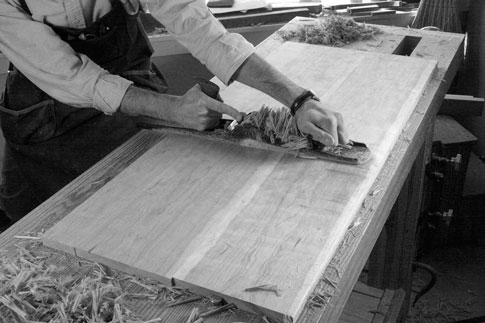
When I teach classes about handplanes, the climax is a contest where we see who can plane a 3/4” x 6” x 12” board to perfection – both to the try square and to the eye.
Last year at one of the classes, one of the young students in the front row took the contest to heart. When he brought his board up to me to evaluate he was out of breath and as wet as a Louisiana underarm.
I thought he had dunked his head in the toilet and was playing a joke on me. Or perhaps he was having a coronary event.
Neither turned out to be true. He was ragged out from planing. It’s a common complaint among readers: Planing is hard work. However, I can generally work all day in the shop without increasing my heart rate beyond what it is during a horror movie. You might think it’s my age (I’m 40), but I think it’s more than that. Over the years I’ve developed some habits that allow me to work steadily all day. Here are a few:
1. Make sure your bench is low enough. A high bench requires you to use the shorter muscles in your arms that tire rapidly. A lower bench allows you to use your legs and abdomen more. When I finally lowered my bench to 34″ it made a huge difference in my work.
2. Step forward during your planing stroke. When planing a longer board (36″ or more), I begin the stroke with one foot in the air and step forward. The act of dropping my foot begins the stroke. This puts gravity on your side. It looks funny (like a Monty Python Silly Walk). But boy does it work.
3. Traverse as much as possible. Planing across the grain allows you to remove more material with less effort. I’ll traverse with my fore plane and my jointer plane. Then a few diagonal strokes with the jointer plane and I’m off to the smoother. The longer I can traverse, the longer I can work.
4. Plan your work around fatigue. One of the great things about hand-tool woodworking is that you can work in short bursts at different tasks and use different muscle groups. For example, I’m building web frames this week. I’ll jointer plane the components. Then cut the tenons. Then the mortises. Then I might smooth plane them and assemble them. Then I’ll move onto the next web frame.
5. Wax your tools. Paraffin wax on the sole of your tool (or a wipe with a non-drying vegetable oil such as jojoba oil) can do wonders. It reduces the effort to push the tool. And – if you apply it to your tools between each board you plane – you also get a short, breather.
6. Sharpen. I’m always amazed at how a sharp tool is easier to push than one that is approaching dull. Sharpening is also a break that can allow you to recover.
7. Pick different secondary woods. For the internal guts of your project, consider using Eastern white pine or basswood instead of using poplar or lower-grade boards of your project’s primary wood (i.e. don’t use rock maple for your drawer bottoms).
8. Don’t smooth plane the inside components. When I plane a carcase side or some internal components, I typically stop with the jointer plane. Sometimes I’ll stop with the fore plane (such as on the underside of a large tabletop). Only the surfaces that show will be smooth-planed. This can cut your planing time dramatically.
9. Always use the coarsest tool possible and take the thickest cut that does not cause tear-out. One 6-thou-thick shaving saves time and effort compared to 12 half-thou shavings. If your wood is mild, take a thick shaving.
So how about you? Any suggestions (besides indenturing an apprentice or buying crystal meth) for increasing your working time?
— Christopher Schwarz